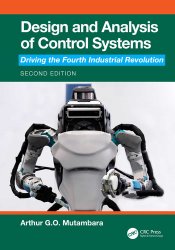 Название: Design and Analysis of Control Systems: Driving the Fourth Industrial Revolution, Second Edition
Название: Design and Analysis of Control Systems: Driving the Fourth Industrial Revolution, Second EditionАвтор: Arthur G.O. Mutambara
Издательство: CRC Press
Год: 2024
Страниц: 795
Язык: английский
Формат: pdf (true)
Размер: 39.1 MB
Written to inspire and cultivate the ability to design and analyse feasible control algorithms for a wide range of engineering applications, this comprehensive text covers the theoretical and practical principles involved in the design and analysis of control systems. This second edition introduces 4IR adoption strategies for traditional intelligent control, including new techniques of implementing control systems. It provides improved coverage of the characteristics of feedback control, root-locus analysis, frequency-response analysis, state space methods, digital control systems and advanced controls, including updated worked examples and problems.
The design and analysis of control systems require tools to enable and speed up the process. There are a number of such computer-based computational tools that can be used. MATLAB and its MATLAB Control System Toolbox are the most popular tools, followed by Simulink Control Design. There is also LabVIEW which is a graphical tool and an alternative programming method to MATLAB. Other tools include SPICE-Based Simulation Software, SimPowerSystems, StateFlow, and Mathcad.
MATLAB Control System Toolbox expands traditional MATLAB to include control system-specific commands. Furthermore, several MATLAB enhancements give added efficacy and functionality to MATLAB and its Control System Toolbox. These include Simulink, Linear-Time Invariant (LTI) Viewer, SISO Design Tool and Symbolic Math Toolbox. Simulink is a graphical programming environment that facilitates modelling, analysis and simulation of dynamic systems through the use of a graphical user interface (GUI). The LTI Viewer is also a GUI platform that simplifies the analysis of linear, time-invariant systems. It is used to view and compare the response plots of SISO and MIMO systems, or several linear models at the same time. The LTI Viewer also permits measurements to be made directly from time and frequency response curves. The SISO Design Tool is a convenient and intuitive design and analysis tool, while the Symbolic Math Toolbox saves labour when making symbolic calculations required in control system design and analysis. Obviously, some of these advanced products may require the purchase of additional software. Most of these control system tools are available from MathWorks.
MATLAB is a high-level technical computing environment ideal for solving mathematical, scientific and engineering problems. It is a multi-paradigm programming language and numerical computing environment developed by MathWorks. The software allows matrix algebra, plotting of data and functions, algorithms development and execution, user interface creation, and integration with programs written in other languages. In engineering, it is an alternative method of solving control system problems, in place of manual manipulation of mathematical representations such as models, equations and diagrams. However, in this book, readers are encouraged to first solve problems in design and analysis of control systems by hand and then deploy MATLAB. This is essential so that understanding and mastery of the concepts are not undermined by automation of design, analysis and solution derivation. Consequently, many examples throughout the book are solved by hand, followed by the suggested use of MATLAB or other tools that automate the design and analysis of control systems. MATLAB and its associated module, the MATLAB Control System Toolbox, are used to solve, analyse, design and simulate control systems.
With the advent of the Fourth Industrial Revolution (4IR) and extensive use of Artificial Intelligence (AI), there are new advanced methods of designing and analysing control systems. Most of these techniques are data-driven, and more specifically AI-based. In this chapter, these latest control system methods are presented. To start with, concepts such as Data-Driven Modelling, Artificial Intelligence, Machine Learning, Deep Learning, Fuzzy Logic, and Artificial Neural Networks are introduced and discussed in detail. AI-based design and analysis of control systems are then presented and evaluated. The 4IR, history of industrial revolutions, key 4IR technologies and their impact, are then discussed. Large-scale examples of 4IR applications are presented, specifically, an Intelligent Fleet Management System is studied. The details of the design and analysis of the control systems for an unmanned autonomous vehicle Drone and a driverless car are outlined, discussed, and evaluated.
Features:
Describes very timely applications and contains a good mix of theory, application, and computer simulation.
Covers all the fundamentals of control systems.
Takes a transdisciplinary and cross-disciplinary approach.
Explores updates for 4IR (Industry 4.0) and includes better experiments and illustrations for nonlinear control systems.
Includes homework problems, case studies, examples, and a solutions manual.
This book is aimed at senior undergraduate and graduate students, professional engineers and academic researchers, in interrelated engineering disciplines such as electrical, mechanical, aerospace, mechatronics, robotics and other AI-based systems.
Скачать Design and Analysis of Control Systems, Second Edition